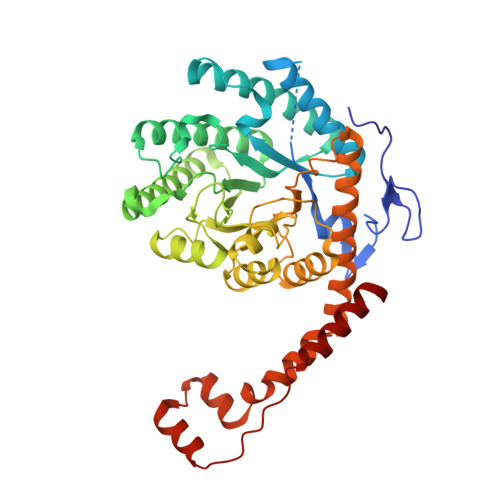Crystal Structure and Functional Characterization of a Xylose Isomerase (PbXI) from the Psychrophilic Soil Microorganism, Paenibacillus sp.
Park, S.H., Kwon, S., Lee, C.W., Kim, C.M., Jeong, C.S., Kim, K.J., Hong, J.W., Kim, H.J., Park, H.H., Lee, J.H.(2019) J Microbiol Biotechnol 29: 244-255
- PubMed: 30602271
- DOI: https://doi.org/10.4014/jmb.1810.10057
- Primary Citation of Related Structures:
6INT - PubMed Abstract:
Xylose isomerase (XI; E.C. 5.3.1.5) catalyzes the isomerization of xylose to xylulose, which can be used to produce bioethanol through fermentation. Therefore, XI has recently gained attention as a key catalyst in the bioenergy industry. Here, we identified, purified, and characterized a XI ( Pb XI) from the psychrophilic soil microorganism, Paenibacillus sp. R4. Surprisingly, activity assay results showed that Pb XI is not a cold-active enzyme, but displays optimal activity at 60°C. We solved the crystal structure of Pb XI at 1.94-Å resolution to investigate the origin of its thermostability. The Pb XI structure shows a (β/α) 8 -barrel fold with tight tetrameric interactions and it has three divalent metal ions (CaI, CaII, and CaIII). Two metal ions (CaI and CaII) located in the active site are known to be involved in the enzymatic reaction. The third metal ion (CaIII), located near the β4-α6 loop region, was newly identified and is thought to be important for the stability of Pb XI. Compared with previously determined thermostable and mesophilic XI structures, the β1-α2 loop structures near the substrate binding pocket of PbXI were remarkably different. Site-directed mutagenesis studies suggested that the flexible β1-α2 loop region is essential for PbXI activity. Our findings provide valuable insights that can be applied in protein engineering to generate lowtemperature purpose-specific XI enzymes.
Organizational Affiliation:
Unit of Polar Genomics, Korea Polar Research Institute, Incheon 21990, Republic of Korea.















